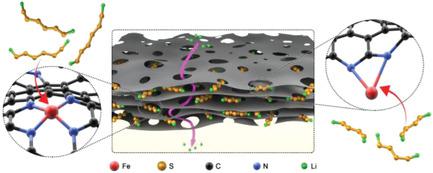当前位置:
X-MOL 学术
›
Adv. Funct. Mater.
›
论文详情
Our official English website, www.x-mol.net, welcomes your feedback! (Note: you will need to create a separate account there.)
Manipulation of Edge‐Site Fe–N2 Moiety on Holey Fe, N Codoped Graphene to Promote the Cycle Stability and Rate Capacity of Li–S Batteries
Advanced Functional Materials ( IF 19.0 ) Pub Date : 2018-12-09 , DOI: 10.1002/adfm.201807485 Yazhou Wang 1 , David Adekoya 2 , Jiqing Sun 2 , Tianyu Tang 1 , Hailong Qiu 1 , Li Xu 2 , Shanqing Zhang 2 , Yanglong Hou 1
Advanced Functional Materials ( IF 19.0 ) Pub Date : 2018-12-09 , DOI: 10.1002/adfm.201807485 Yazhou Wang 1 , David Adekoya 2 , Jiqing Sun 2 , Tianyu Tang 1 , Hailong Qiu 1 , Li Xu 2 , Shanqing Zhang 2 , Yanglong Hou 1
Affiliation

|
Graphene‐based materials have been widely studied to overcome the hurdles of Li–S batteries, but suffer from low adsorptivity to polar polysulfide species, slow mass transport of Li+ ions, and severe irreversible agglomeration. Herein, via a one‐step scalable calcination process, a holey Fe, N codoped graphene (HFeNG) is successfully synthesized to address these problems. Diverging by the holey structures, the Fe atoms are anchored by four N atoms (Fe–N4 moiety) or two N atoms (Fe–N2 moiety) localized on the graphene sheets and edge of holes, respectively, which is confirmed by X‐ray absorption spectroscopy and density functional theory calculations. The unique holey structures not only promote the mass transport of lithium ions, but also prohibit the transportation of polysulfides across these additional channels via strong adsorption forces of Fe–N2 moiety at the edges. The as‐obtained HFeNG delivers a high rate capacity of 810 mAh g−1 at 5 C and a stable cycling performance with the capacity decay of 0.083% per cycle at 0.5 C. The concept of holey structure and introduction of polar moieties could be extended to other carbon and 2D nanostructures for energy storage and conversion devices such as supercapacitors, alkali‐ion batteries, metal–air batteries, and metal–halogen batteries.
中文翻译:

在有孔的Fe,N共掺杂的石墨烯上处理边缘站点的Fe-N2部分,以提高Li-S电池的循环稳定性和倍率容量
石墨烯基材料已被广泛研究以克服Li-S电池的障碍,但其对极性多硫化物的吸附性低,Li +离子的质量传递缓慢以及严重的不可逆结块。在此,通过一步可缩放的煅烧过程,成功地合成了多孔的Fe,N共掺杂石墨烯(HFeNG),以解决这些问题。通过有孔结构发散,Fe原子被四个N原子(Fe–N 4部分)或两个N原子(Fe–N 2)锚定。X射线吸收光谱法和密度泛函理论计算证实了这一点)。独特的多孔结构不仅促进了锂离子的质量迁移,而且还通过边缘处Fe–N 2部分的强大吸附力阻止了多硫化物跨这些额外通道的迁移。如此获得的HFeNG可提供810 mAh g -1的高倍率容量 在5 C下具有稳定的循环性能,在0.5 C下每个循环的容量衰减为0.083%。有孔结构和引入极性部分的概念可以扩展到其他碳和2D纳米结构,用于能量存储和转换设备,例如超级电容器,碱离子电池,金属空气电池和金属卤素电池。
更新日期:2018-12-09
中文翻译:

在有孔的Fe,N共掺杂的石墨烯上处理边缘站点的Fe-N2部分,以提高Li-S电池的循环稳定性和倍率容量
石墨烯基材料已被广泛研究以克服Li-S电池的障碍,但其对极性多硫化物的吸附性低,Li +离子的质量传递缓慢以及严重的不可逆结块。在此,通过一步可缩放的煅烧过程,成功地合成了多孔的Fe,N共掺杂石墨烯(HFeNG),以解决这些问题。通过有孔结构发散,Fe原子被四个N原子(Fe–N 4部分)或两个N原子(Fe–N 2)锚定。X射线吸收光谱法和密度泛函理论计算证实了这一点)。独特的多孔结构不仅促进了锂离子的质量迁移,而且还通过边缘处Fe–N 2部分的强大吸附力阻止了多硫化物跨这些额外通道的迁移。如此获得的HFeNG可提供810 mAh g -1的高倍率容量 在5 C下具有稳定的循环性能,在0.5 C下每个循环的容量衰减为0.083%。有孔结构和引入极性部分的概念可以扩展到其他碳和2D纳米结构,用于能量存储和转换设备,例如超级电容器,碱离子电池,金属空气电池和金属卤素电池。


























 京公网安备 11010802027423号
京公网安备 11010802027423号